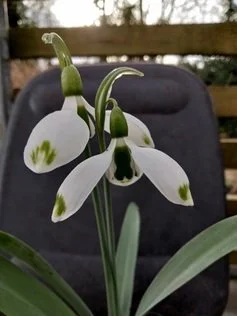
February, is a marvelous month for one of our best loved winter flowering plants to peak in this month. This marvelous plant being the humble snowdrop. You can visit many gardens the length and breadth of the country looking at great swathes of snowdrops flowering in woodland situations, on a (warm) day plus 2 degrees and the sun is shining through the trees most snowdrops produce a pleasant scent. However, look closer and not all snowdrops are the same…
We commonly grow in our gardens two varieties of snowdrop (Galanthus). These being Galanthus nivalis and Galanthus nivalis floro plena, and many of the gardens we visit at this time of year are predominantly are these two varieties. In some gardens that open to the public have more than these two varieties.
Ever since the 19th century, Snowdrops have been crossed and bred to produce literally hundreds of varieties from around 20 wild species and then the hybrids from these crosses have been hybridized too. Even here in Somerset we have a man James Allen who was the first person to start hybridizing wild snowdrops. Although James Allen created more than 500 varieties, some you can still buy today and those being Galanthus Merlin and Magnet. To learn more about this amazing man and the snowdrops he created then go to the Shepton Mallet snowdrop festival 12-18th February 2024. You can buy many types of snowdrops from specialist growers at this festival.

You can get snowdrops flowering as early as October and the last flowering late March. Snowdrops fall into four main groups single, double, green and gold.
Galanthus nivalis
Narrow grey green leaves up to 6 inches in length. The flowers are single, 3 larger outer petals and 3 inner petals. The inner petals have a green marking on the ends of the petals. Flowering from February in to March.
Galanthus nivalis floro-plena
The same as above with the exception that the leaves are shorter and the flowers are doubles. It also flowers later in February.
Galanthus Big Bertha
This snowdrop belongs to the elwesii and typically has broad glaucus grey leaves. The flower is large with a distinctive green marking on each of the three outer petals. The green on the inner three petals is also much more pronounced. Making this variety a green snowdrop.

Galanthus Ashwick Green
This a nivalis type and the same as Galanthus floro-plena with the exception to the outer larger petals have a green marking at the tip of each.
Galanthus Spindlestone Surprise
This a cross between Galanthus Plicatus and Nivalis sandersii. It makes a strong growing gold flowering snowdrop. The gold is highlighted on the ovary at the top of the flower and where green would be in the center is now gold (yellow)

As wonderful seeing sweeps of snowdrops flowering, there are other plants that flower at this time as well and helps complement the snowdrops in all their glory and makes our seeing the more enjoyable. Such plants as:
Crocus tommasinianus (see right)
A great small Crocus for naturalizing among snowdrops or even just in the lawn. It has lovely lavender-coloured flowers with cheery orange stamens in the center. Also comes in a dark purple form with the same stamens.


Eranthis hyemalis
The winter aconite. This amazing golden yellow flowered plants with a fun green ruff under the petals. When the sun shines the flowers open and are most cheery in the winter days. Great for naturalizing with snowdrops.

Cyclamen Coum
A most wonderful bulb flowering from early December right the way through to March. It has small kidney shaped leaves that are dark green or pewter (silvering of the leaves). The flowers are dark pink/red, pale pink or white. Super hardy for such a dainty plant and is a joyous plant to be with snowdrops.
Iris reticulata Kathrine hodgkins
This early flowering bulbous Iris produces large iris flowers from early as January right through February and are often found flowering with snowdrops. These bulbs produce flowers from white to rich blues and purple. Even some are yellow. A lovely variety and naturalizes quickly is Iris Reticulata Kathrine Hodgkins. But there are many others of this versatile little bulb.

Hellebores

Helleborus orientalis, known as the Lenten rose but it does tend to flower much earlier than Easter. I have a variety in my own garden that’s flowering at Christmas every year. These lovely herbaceous plants with red through to pink and white and some yellow and orange flowers. Some are single and some are double flowering. Once the old leaves are cut away the flowers on the stems are clearly seen. They make a great addition planted with snowdrops.